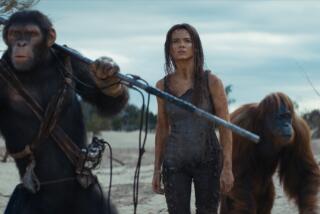It’s Been a Jungle Out There
- Share via
Authenticity, or lack of it, has always been an issue in Tarzan movies. Despite the enormous popularity of Edgar Rice Burroughs’ 1912 pulp epic “Tarzan of the Apes,” Hollywood initially was hesitant to touch it, what with all the hard-to-film vine-swinging and ape-speak.
The first Tarzan movie did not appear until 1918. Director Scott Sidney shot a number of scenes in the sycamore groves of Griffith Park, but then, needing better jungle atmosphere, he moved his crew to the mossier environs of Morgan City, La. When it came to casting the apes, the best Sidney could do was to get human recruits from a New Orleans athletic club and stitch them into monkey suits.
For the next 80 years, apes would continue to be a weak link in Tarzan movies. The closest Hollywood came to simian satisfaction was Cheetah, the slapstick chimp of MGM’s and RKO’s Tarzans of the 1930s and ‘40s. The ultimate recognition of the ape gap came in Disney’s 1997 Tarzan parody, “George of the Jungle,” whose leading banana-eater, a hair-suited homo sapien, speaks Oxonian polysyllabics and serves as the brain behind George’s (Brendan Fraser) brawn.
Now, with Disney’s recently opened adaptation of “Tarzan,” audiences can get a sense of the savagery and sensitivity of the ape world described so vividly in the original Tarzan tale. While the plot of the new “Tarzan” is Disneyed-down--Burroughs’ pointedly Darwinian romance becomes a kinder, trendier paean to the virtues of adoption and intercultural tolerance--the miracle of Disney’s animation succeeds in bringing the image, if not the story, of Tarzan full circle. For the first time, there is no need to pretend that Tarzan’s ape mother Kala is really some sweaty schlub from Central Casting. When this tenderly rendered, full-figured gorilla cradles baby Tarzan in her enormous arms, the bond is mother-child, naturally, but is also a bond between two creatures born of the same drawing board. No previous Tarzan movie has come close to conveying such intimacy, such commonality, which is the very core of the Tarzan story.
*
Indeed, it is as if Tarzan had been caged for all these years, waiting for animation to set him free. No one ever believed that the vine-swinging of the ancient Tarzan films was anything other than stand-in circus stuff, and the deep, dark jungle looked uncomfortably similar to Sherwood Forest. In the new “Tarzan,” the jungle is thoroughly primeval--one part National Geographic, one part “Fantasia”--and this year’s limber, dreadlocked Tarzan moves through its woven and saturated vastness with the grace of Burroughs’ literary antecedent. At times he is uncannily apelike--his hands are feet, his feet hands--and other times he is everything we hope a human athlete can be, with infinite spring and strength, and a precise gyroscope behind those gimlet eyes.
Long before his death in 1950, not far from Tarzana, the town he founded partly with movie money, Burroughs had given up hope that Hollywood would adhere to his vision of Tarzan, the orphaned son of English nobility raised by apes in Africa. He had pushed hard at first for a more faithful treatment and had even made his own Tarzan movie, but the Depression, the promise of generous royalties, and the doublespeak of producers had eroded his control. Chimps and sycamores were the least of his concerns.
What upset Burroughs most was the bastardization of the Tarzan character. Tarzan, after all, was Lord Greystoke, an exquisite exemplar of aristocratic breeding. Physically, he was “clean-limbed,” meaning supple and not brutishly hairy or muscle-bound. True, Tarzan had answered the call of the apes, but he embodied “the best characteristics of the human family from which he was descended and the best of those which mark the wild beasts.”
Not surprisingly, the selection of Elmo Lincoln, who had played a hulking blacksmith in “Birth of a Nation,” for the first Tarzan film irked Burroughs immensely. Lincoln had the mien of a “prize bear,” Burroughs confided early on, and after he finally deigned to see the finished film, he announced, “The story is not mine.”
Lincoln manages some hand-over-hand tree-climbing in the 1918 “Tarzan of the Apes” but attempts no vine-swinging or swimming, compulsory stunts of later ape-men. He does wrestle a doped lion, and he pounds his chest and emits the victory cry of the bull ape, though of course audiences heard only the sound of silence. For all its awkwardness, Sidney’s “Tarzan” was one of the first films to gross $1 million, a windfall that emboldened a queue of movie makers to try their hand at the genre.
To Burroughs’ relief, Lincoln was not chosen for the lead in 1920’s “The Revenge of Tarzan”--but that was cold comfort when the author learned that the part had gone to Gene Pollar, a New York fireman whose only audition was to slide down the pole at his firehouse. At least “Revenge” honored the Greystoke side of the Tarzan character. Pollar wears evening clothes in early scenes before donning an Alley Oop-ish over-the-shoulder leopard skin.
Burroughs had only himself to blame for the next Tarzan of note, for he picked him himself. James Pierce had been a football star at Indiana University before moving to California. Burroughs’ daughter Joan had invited him to a pool party at Tarzana, and when Burroughs spotted Pierce, dripping wet, he declared that he came “as near to being Tarzan of the Apes . . . as any man I have ever seen”--a surprising remark, given that Pierce, though 6-foot-3 and a football player, looked more like a gangly tennis pro than a jungle hero. Perhaps Burroughs’ objectivity was clouded by the fact that Pierce and Joan Burroughs were lovers and eventually married.
“Tarzan and the Golden Lion,” produced by Joseph Kennedy’s studio, FBO, in 1927, was radiant in all ways but one: Pierce was a flop. He gamely attempts some shinnying and swinging but commits the faux pas of wearing slippers while on jungle duty.
With the 1930s and the Depression, Burroughs grew less fussy. For a handsome fee, Burroughs was willing to let MGM have its way with the Tarzan character. “Tarzan the Ape Man” (1932), starring gorgeous Olympian Johnny Weissmuller, was the first Tarzan talkie, and when MGM changed the pronunciation of “Tarzan” from TAR-zn to Tar-ZAN, Burroughs remarked, “I don’t give a damn what they call him as long as their checks come regularly.” (The name “Tarzan” is ape-speak for “white skin,” Burroughs wrote.)
Nor did he mind that MGM overlooked Tarzan’s Greystoke genes and reduced the Lord of the Jungle to a feral simpleton. The closest Burroughs came to public protest was his 1933 novel, “Tarzan and the Lion Man,” in which the true Tarzan travels to Hollywood and auditions for the role of the movie Tarzan, only to be told that he is “not the type at all.”
The part goes instead to an adagio dancer.
*
From the ‘30s on, the Tarzan movies overshadowed the novels, and with only a couple exceptions, Tarzan is portrayed as a brave and lovable lug. More people remember Buster Crabbe’s goofy, hunky Tarzan (“Tarzan the Fearless,” 1933) than Herman Brix’s almost Holmesian portrayal in “The New Adventures of Tarzan,” produced by Burroughs’ own company, Burroughs Tarzan Enterprises, in 1935.
And for all the high marks Christopher Lambert received for his nuanced performance in “Greystoke: The Legend of Tarzan” (1984), a much bigger stir was created by “Tarzan, the Ape Man” (1981), wherein Bo Derek’s fleshy Jane steals the show, and Miles O’Keeffe, as Tarzan, utters not a word.
A slew of other Tarzans have swung in and out of the spotlight--including Frank Merrill, Glenn Morris, Lex Barker, Gordon Scott, Jock Mahoney, Denny Miller, Mike Henry, Ron Ely, Wolf Larsen, Joe Lara and Casper Van Dien--but each seemed a further cry from Burroughs’ ideal than the next. Perhaps the most heinous insult came in 1996 with “Jungle Heat,” an X-rated CD-ROM in which Tarzan plays “the wrong kind of swinger.”
Which brings us at last to Disney’s G-rated “Tarzan.” Before starting the project, Tom Schumacher, president of feature animation at Disney, reread the 1912 “Tarzan of the Apes”--but he made a point of not rerunning the old movies. (Someone at Disney must have watched the old movies, however, for Burroughs’ Jane is from Baltimore; Disney’s Jane, voiced energetically by Minnie Driver, is English, similar to the MGM films.)
If he and his team have wavered at all in their endeavor to honor the original text, their sins are mostly ones of omission. For instance, Disney steers clear of African natives, a staple of the books and movies but PC quicksand nowadays. And to keep the story trim, Disney lops off the Greystoke limb of the family tree. Instead, Schumacher says, “We chose to focus on Tarzan’s more essential quandary: ‘Am I human? What does it mean to be human?’ ”
The ape-man’s predicament comes to a head when his gorilla mother Kala shows him a photo of his birth parents, both of whom die shortly after being shipwrecked on the African coast. Eventually he must choose between his adoptive clan and going to England with plucky Jane and the rest of her safari party. In the end he comes to appreciate that, despite having to straddle two worlds, it’s all one big happy family--a sentiment drummed home by Phil Collins’ theme song.
The other thing Disney does so wisely is avoid making Tarzan a superman. Burroughs’ Tarzan was fearless and almost tireless, but his charm is that he is human, not a Hollywood cutout. “You meet Tarzan when he’s most vulnerable, when he’s a child,” Schumacher says. “You realize how defenseless he is. He learns to take care of himself, but you know that at any time he could stumble. That’s what happens when he meets Jane.”
Over and over, though, it is Disney’s obsession with credibility that provides the most delicious entertainment. When one of the elephants claims to have sighted a piranha in the river, another lectures that piranhas are not native to Africa. Before creating scenes with gorillas, baboons and monkeys, animators studied the real things, and the results are stupendous.
With Tarzan, they do an even better job. No more adagio dancers or poolside Lotharios. Much has been made of the surfing-shredding-skateboarding inspiration for the appearance and athleticism of Disney’s Tarzan, and rightly so. Animator Glen Keane notes that in addition to studying actual apes in motion, he watched lots of videos of extreme sports. Tarzan, by virtue of his man-among-apes circumstances, is a counterculture character, and it makes perfect sense that Disney’s Tarzan borrow from today’s counterculture.
Tarzan doesn’t just imitate the apes. He has moves, and like any person desperately trying to prove himself, he’s a bit out of control--part survivalist, part showoff as he bounds from branch to branch and throws an extra spin into each glide down a slippery trunk.
But there is another source that should not be overlooked here. The very best part of the original Tarzan story is the manner in which the jungle hero races, soars, swings and swoops through the treetops. In a way, the old jock-in-loincloth movies made jungle stunts look too easy, and in an era of sci-fi gimmickry, we forget just how much talent and enthusiasm it takes to be a real Tarzan. To date, only two instruments have been able to make Tarzan so exhilaratingly believable: the pen of Burroughs and the cyber-brushes of Disney.
As for the new Tarzan’s yell--well, you can’t have everything.
*
John Taliaferro is the author of “Tarzan Forever: The Life of Edgar Rice Burroughs” (Scribner). He will be at Vroman’s Bookstore in Pasadena on Wednesday at 7 p.m.
More to Read
Only good movies
Get the Indie Focus newsletter, Mark Olsen's weekly guide to the world of cinema.
You may occasionally receive promotional content from the Los Angeles Times.








